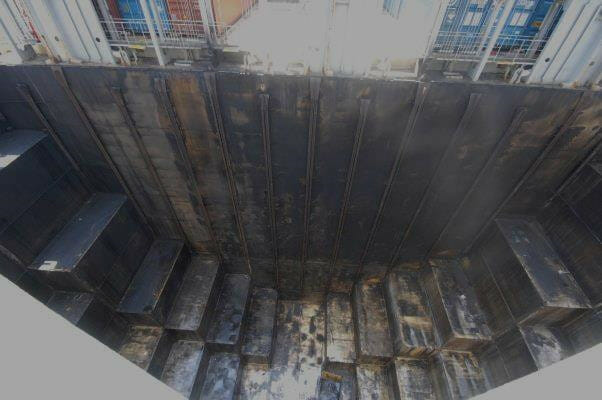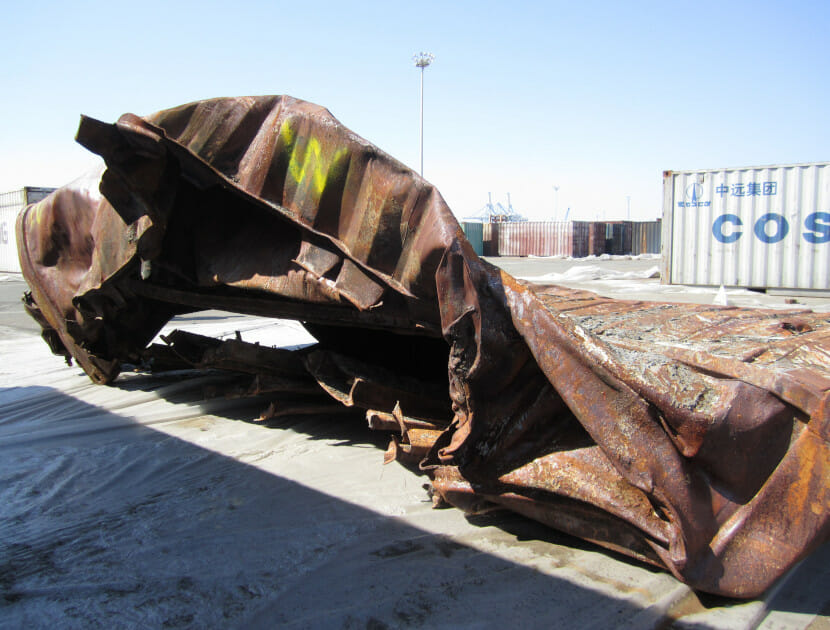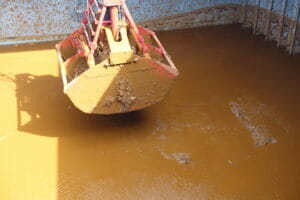CASE STUDY: WHICH OCCURRED FIRST, THE FIRE OR THE EXPLOSION?
Hawkins investigated the cause of a fire and explosion on board a container ship on behalf of an insurer of various cargo interests. One of the key questions, as always, was which occurred first, the fire or the explosion?
FIRE DETECTION AND FIREFIGHTING ON CONTAINER SHIPS
Cargo holds are often fitted with an active smoke detection system, whereby air is drawn from the cargo holds through metal tubes. That air is then passed through smoke detectors which, in the event of activation, alert the crew to a possible fire.
There are two main firefighting methods on a container ship. The first is to fill the cargo hold or engine room where the fire has been detected with carbon dioxide (CO2) gas. The gas is delivered from banks of gas bottles stored in a designated compartment to the affected area through the smoke detector sampling tubes, the second is to use traditional fire hoses or misting/sprinkler systems to apply water to the affected area. In extreme cases, where a fire in a cargo hold cannot be controlled, it is sometimes possible flood the relevant cargo hold with water. This is often a last resort measure as it will probably result in at least the partial loss of the cargo in that hold and might cause the vessel to become unstable.
HEATED FUEL TANKS ON CARGO VESSELS
The majority of larger container ships are driven by reciprocating engines fuelled with heavy fuel oil (HFO), which is a high viscosity diesel fuel. HFO is stored in bunker fuel tanks (on some vessels such as the larger container ships those tanks can occupy the void between the sides of the vessel and the cargo holds, those tanks are referred to as “wing tanks”). The HFO is kept liquid and at a viscosity suitable for pumping to the engine room by heating it to between 50°C and 70°C with steam heating pipes routed through the bunker tanks.
INVESTIGATING THE CAUSE OF THE FIRE
Since this investigation was carried out on behalf of cargo interests, rather than the owners of the vessel, only limited information concerning the circumstances of the incident was provided. From media sources we became aware that the crew reported an explosion and subsequently smoke was seen coming from a cargo hold. Later a fire in that cargo hold was apparently extinguished by the application of the vessel’s on-board CO2 fire extinguishing system, but a few days after deployment of the CO2 the temperature within the hold had increased again and further CO2 was discharged into the hold. A specialist marine salvage team was appointed and they ultimately decided to flood the affected hold partially with sea water.

The patterns of fire damage to the cargo hold, the containers within that hold and the bulkhead between the affected hold and one adjacent to it, indicated that the incident was centred on, or close to, a container that stood on and next to a heated wing tank extension.
There was no physical evidence to indicate that the incident was caused by an electrical fault within the cargo hold. The only lights within the hold were remote from the most severe area of fire damage. Even if the lighting had been switched on and developed a fault, it would seem unlikely that the fire would spread, or be sufficiently intense to cause damage to the containers without the fire detection system operating and alerting the crew to the fire before the explosion occurred. There were no reefer (refrigerated container) power supplies or refrigerated containers in the cargo hold and so it was clear that the fire was not caused by faulty refrigeration equipment, or the electricity supplies to them.
Since the fire originated within a cargo hold, and no loose readily ignitable cargo was held there, i.e. all of the cargo was held within containers, nor was there any signs of accumulations of combustible detritus (rubbish/waste) there was no realistic prospect for the fire to be associated with carelessly discarded smoker’s materials.
There was no suggestion that hot work (welding or grinding) was being undertaken on the ship before the incident and the vessel appeared to be generally in good condition.
There was scorching damage to the vessel outside the cargo hold, namely to the deck bollards, the ladders, hand rails and the lashing bridge crossways. That damage indicated that hot gases were ejected from the hold and impinged on the painted metal surfaces. The most prominent feature was the scorching damage to the paint on the bollards at a level below the coaming (the upstand which forms the sides of the cargo hold that extend about 2 meters above the deck). This scorching indicated that hot gases were ejected under pressure from the cargo hold through ventilation louvres, and at a time before the ventilation covers of the hold were closed in order for the CO2 fire suppression system to be released. The inference being that the fire was not the first event, but rather an explosion occurred, which then initiated the fire.

The damage to the container at the seat of the incident indicated that the container walls and doors had been “blown” outwards before the container had collapsed. The roof of the container had also been displaced upwards during the explosion which, considering the damage to the container as a whole (it was crushed by the containers above during the fire), must have occurred before the container collapsed. This again suggests that the explosion occurred either before the fire or at least during its very early stages.
The remains of what appeared to be the lids of plastic drums, which had sustained varying degrees of fire damage, were found on top of surfaces, and below other debris throughout the hold. The position of these lids and the associated smoke protection marks indicated that they had been “blown” across the hold at a very early stage of this incident. It seems most likely that the plastic drums were those for the contents of the cargo stowed within the only container that had exploded. The fact that some of the drum lids were unburned indicates that the explosion preceded a major and sustained fire within that container.
CARRYING DANGEROUS GOODS
Insurers of cargo vessels generally require the owners and operators to adhere to internationally recognised guidance concerned with maximising the overall safety of the vessel, the crew, and the cargo. One part of that guidance is known as the International Maritime Organisations Dangerous Goods Code (IMDG code) which is the internationally accepted guideline for the transportation or shipment of dangerous goods or materials by a vessel on water. Even a cargo which might be quite innocuous in small quantities can display dangerous properties when transported in large quantities, especially if those large quantities of material are exposed to environmental conditions such as moisture or heat, during or prior to loading, or during a voyage.
The cargo manifest provided to date shows that no dangerous cargo had been declared and subsequently stowed in the relevant cargo hold. The container at the seat of the explosion was, according to the manifest information, carrying a non-hazardous material, of the type that is known not to self-heat or explode. It seems most likely therefore that the explosion was caused by the mis-declared contents of the container.
There was a grey sludge-like material and debris found throughout the hold, which the author considered had the appearance of residue left after an explosion involving calcium hypochlorite (this had been documented by Hawkins in previous cases). The similarities of the appearance of the debris, the container lids, and the fact that the crew had difficulty fighting the fire using CO2 all suggest that an explosion involving calcium hypochlorite was a plausible cause of this explosion and fire.
Samples of the sludge and debris were taken from inside the cargo hold and from the scorched areas surrounding it. These samples were subject to chemical characterisation analysis by gas chromatography mass spectrometry, and by x-ray diffraction. Most significantly, those analyses revealed that elevated levels of calcium were present in all of the samples, and significantly in a sample recovered from the coaming outside the hold and below a vent. This deposit cannot be attributed to substances mixed in the hold with the firefighting water. In that respect, the source of the calcium must be attributed to material that was volatilised during the incident and deposited below on the coaming, probably during the explosion and when gasses vented under pressure from the ventilation louvres.
MIS-DECLARED CARGO – CALCIUM HYPOCHLORITE
Calcium hypochlorite, chemical formula Ca(OCl)2, is an IMDG listed cargo, which is well known to have caused explosions and fires on ships. It should be segregated from other cargo and shaded from sunlight, away from heat sources (such as HFO wing tanks) and in a space with free air circulation. The IMDG documents suggest that no more than 14 tonnes are carried per load. A 20 ft shipping container will potentially contain significantly more than this figure.
In bulk quantities, and when exposed to temperatures in excess of around 50°C, calcium hypochlorite can begin to decompose chemically. The precise mechanism of the decomposition process is complex, but in simple terms it involves the evolution of several relatively stable calcium containing species as well as chlorine gas, most importantly oxygen and heat are liberated. The decomposition of the hypochlorite ion is shown below, where ClO– is the hypochlorite ion as dissociated from the calcium ion Ca 2+:
2 ClO– → 2 Cl– + O2
The combination of an oxygen rich environment and elevated temperatures creates conditions favourable for rapid decomposition and combustion, if well constrained, for instance in a shipping container, those conditions may lead to an explosion.
It is significant that in this and other calcium hypochlorite fire/explosion cases on ships, the application of the vessel’s on-board CO 2 firefighting system has been relatively ineffective. This is due to the increased oxygen concentration in the locality and a reaction between calcium hypochlorite and carbon dioxide, which has the effect of rendering the application of CO2 ineffective, or at the very least reduces its efficacy. This explains why the fire resulting from the explosion in this case was difficult to contain.
The reaction between calcium hypochlorite and carbon dioxide is shown below and shows how carbon dioxide gas is effectively sequestered by calcium hypochlorite:
Ca(ClO)2 + CO2→CaCO3 + Cl2
Guidance concerning the shipping of Calcium Hypochlorite is provided by IMDG code and requires containers transporting the material to be treated more carefully than other non-dangerous cargo. Consequently, it is more expensive to ship Calcium Hypochlorite than a similar quantity of a less dangerous cargo. It is for that reason that it is not uncommon to find shipments of Calcium Hypochlorite have been mis-declared as another cargo. The result is that there will always be the potential for this cargo to be stowed in inappropriate locations on vessels (next to heat sources or other cargo that might burn readily) and therefore, until this problem is eradicated, the risk of explosion and fire will remain.
ABOUT THE AUTHOR
Paul Willis began on-scene and laboratory based fire investigation in 2005. Since then he has investigated the cause and circumstances of incidents of fire and explosions involving vehicles, domestic residences, retail, agricultural and industrial premises.
Paul is a member of Hawkins specialist International and Shipping Incidents team and has investigated ship fires involving bulk cargo and container ships
worldwide.






